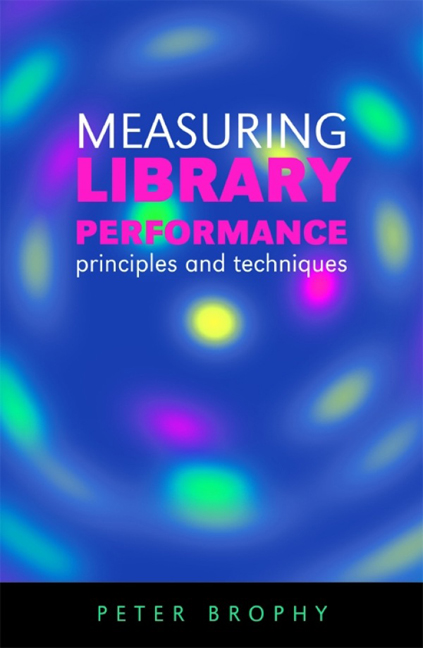Book contents
- Frontmatter
- Contents
- List of figures
- List of tables
- Preface
- Acronyms and abbreviations
- 1 Background
- 2 Theoretical considerations
- 3 User satisfaction
- 4 Impact on users
- 5 Social and economic impact
- 6 Inputs
- 7 Processes
- 8 Outputs
- 9 Staff
- 10 Infrastructure
- 11 Services for all
- 12 Benchmarking
- 13 The balanced scorecard
- 14 Standards
- Appendix 1 Data collection methods
- Appendix 2 The analysis of data
- Appendix 3 The presentation of results
- Index
Appendix 3 The presentation of results
Published online by Cambridge University Press: 08 June 2018
- Frontmatter
- Contents
- List of figures
- List of tables
- Preface
- Acronyms and abbreviations
- 1 Background
- 2 Theoretical considerations
- 3 User satisfaction
- 4 Impact on users
- 5 Social and economic impact
- 6 Inputs
- 7 Processes
- 8 Outputs
- 9 Staff
- 10 Infrastructure
- 11 Services for all
- 12 Benchmarking
- 13 The balanced scorecard
- 14 Standards
- Appendix 1 Data collection methods
- Appendix 2 The analysis of data
- Appendix 3 The presentation of results
- Index
Summary
■ Introduction
It is sometimes tempting to breathe a sigh of relief when the data collection is finished and the analysis is complete. The results are to hand, so what else needs to be done? In fact the next stage is one of the most crucial – the presentation of results to the intended audience in a manner which is both clear and unambiguous and which highlights critical issues. Hopefully, the purpose of the exercise will have been decided before the data collection itself was designed, so that the intention behind the whole activity will be clear. However, it is worth reiterating at this stage that performance measurement can be carried out for a wide range of reasons including:
• advocacy and public relations, or even self-justification
• accountability over the short or long term
• management of services with a view to change and improvement
• reallocation of resources between services, including innovation.
■ Deciding on the message
The most critical part of presentation is deciding on what the key message should be. Of course there may be more than one but it is worth bearing in mind that as the number increases the impact diminishes! A useful rule of thumb is that, except for extensive evaluations, it should be possible to write an executive summary (see also below) which is no more than one page in length. A reader with limited time will be able to absorb the main messages in this way, using the body of the report to explore detailed findings and the logical argument.
Regular reports may have a standard format or house style, so that there is no need to devise a new one each time, although such formats will of course need to be reviewed from time to time.
■ Deciding on the audiences
With an internal study, the audience may be obvious – the managers who commissioned it. However even here it is worth considering whether there are other audiences who need to, or have a right to, know about your findings. For example, a study of library circulation will also be of interest to staff who work on the issue desk.
Information
- Type
- Chapter
- Information
- Measuring Library Performanceprinciples and techniques, pp. 224 - 234Publisher: FacetPrint publication year: 2006
